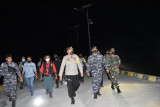Jakarta (ANTARA) - Infrastructure and facilities are being installed in Labuan Bajo, West Manggarai district, East Nusa Tenggara, as part of efforts to turn it into a super premium destination that will host world leaders besides the well-heeled.
President Joko Widodo (Jokowi), who visited Labuan Bajo in January and October this year, has designated it as one of the 10 top priority tourist destinations, tagged Beyond Bali, along with Borobudur in Central Java, Lake Toba in North Sumatra, and Mandalika in West Nusa Tenggara.
Indonesia is scheduled to take over the presidency of the G20 and the chairmanship of ASEAN, and the government is intent on preparing Labuan Bajo as the venue for the G20 Summit and the ASEAN Summit in 2023.
Tourism and Creative Economy Minister Wishnutama Kusubandio has urged hotels and restaurants in Labuan Bajo to implement health protocols based on Cleanliness, Health, Safety, and Environmental Sustainability (CHSE) standards.
The CHSE certification is crucial for the tourism industry, particularly hotels and restaurants, to reclaim tourist confidence.
"This is aimed at offering a sense of security and comfort to tourists when they visit a destination that applies the health protocols. This certification has been aligned with world tourism organizations, such as the UNWTO and CTTI, as well as the Health Ministry," Kusubandio explained.
With construction in progress, the Komodo National Park has temporarily shut down the Loh Buaya tourist resort, which is situated within the Komodo National Park. The area has facilities for tourists, including cottages, a cafeteria, a shelter, and trails, and has become a popular location to observe wildlife.
It was deemed necessary to temporarily close Loh Buaya to enable the process of rearrangement of the natural tourism facilities and infrastructure on the island, a task that has been entrusted to the Ministry of Public Works and Public Housing, head of the Komodo National Park, Lukita Awang Nistyantara, explained on November 15, 2020.
Furthermore, the tourist resort has been temporarily closed from October 26, 2020 to June 30, 2021 for improving services and ensuring the safety of tourists, Nistyantara remarked.
"This temporary closure will be evaluated periodically, taking into account the development of natural tourism infrastructure at the Loh Buaya Resort, SPTN (National Park Management Section) Region I, Rinca Island," he stated.
Based on data from the Komodo National Park, the Loh Buaya Valley is home to 60 Komodo dragons. Of the 60 Komodo dragons, at least 15 usually roam near the vicinity of the ongoing construction work and some are accustomed to human presence.
Earlier, the Environmental Affairs and Forestry (KLHK) Ministry had assured that the development of facilities and infrastructure to support tourism at the Komodo National Park will align with the principles of conservation.
The construction work is being conducted with utmost care, Wiratno, the ministry's director general of conservation of natural resources and ecosystems, noted in a statement in October, 2020.
Facilities and infrastructure being constructed at the Pasir Panjang village, Komodo sub-district, West Manggarai district, East Nusa Tenggara, comprise a pier, beach guard facility, deck, and information center, as well as huts for officers, researchers, or guides, Wiratno remarked.
Trucks, excavators, and heavy equipment required to carry construction material are being used prudently, he said.
"In order to ensure the safety and protection of Komodo dragons as well as workers, all development activities are being monitored daily by five to 10 rangers. They are intensively monitoring the presence of Komodo dragons, including under buildings, former buildings, and under trucks carrying materials," he remarked.
Other tourist spots on Komodo Island, Karang Makasar, Batubolang, Siaba, and Mawan remain open to the public, including to tourists.
In the past few years, the population of Komodo dragons has increased to reach 3,022 in 2019, according to the Forestry and Environment Ministry. In 2018, the total Komodo population numbered 2,897.
Most of this population is concentrated in the islands of Komodo and Rinca in East Nusa Tenggara, with the authority spotting just seven, 69, and 91 Komodo dragons in the three neighboring islands of Nusa Kode, Gili Motang, and Padar, respectively.
"The Komodo dragon population in Loh Buaya Valley is five percent of the total count in Rinca Island, or some 66 species. The population in Loh Buaya during the past 17 years was relatively stagnant and slightly increased during the past five years,” Wiratno noted in the statement.
Minimal contact with humans will help in preserving the species, he said. Despite tourism activities in the 500-hectare Loh Buaya Valley, some 2.5 percent of Rinca Island covers 20 thousand hectares of the area.
The national park, which was declared a biosphere reserve under the UNESCO Man and Biosphere Programme in January 1977, spans 173,300 hectares, comprising 33.76 percent of land and 66.24 percent of water. In 1991, the national park was declared a UNESCO World Heritage Site.
Of the total area, 824 hectares, or 0.4 percent, has been designated as a Land Tourism Zone and 1,584 hectares, or 0.95 percent, as a Marine Tourism Zone.
"Development of nature tourism was restricted only in these zones. This is part of the prudent principle applied in the management plan of the Komodo National Park," Wiratno stated, adding that the development of supporting facilities in the area has reached 30-percent completion and is targeted to be ready by 2021.
However, executive director of Indonesia's environmental NGO Walhi NTT, Umbu Wulang Tanaamahu Paranggi, had said earlier that the government should solely channel its efforts towards conserving the Komodo dragons and their ecosystem instead of developing infrastructure for tourism, which can be detrimental to the ecosystem.

Balancing infrastructure push with conservation Labuan Bajo


Komodo dragon in Rinca Island, West Manggarai District, East Nusa Tenggara (NTT) Province. (ANTARA/Bernadus Tokan)
The Komodo dragon population in Loh Buaya Valley is five percent of the total count in Rinca Island, or some 66 species. The population in Loh Buaya during the past 17 years was relatively stagnant and slightly increased during the past five years








